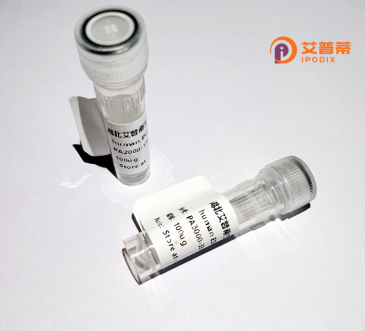
| 纯度 | >90%SDS-PAGE. |
| 种属 | Human |
| 靶点 | SLCO1B1 |
| Uniprot No | Q9Y6L6 |
| 内毒素 | < 0.01EU/μg |
| 表达宿主 | E.coli |
| 表达区间 | 1-691 aa |
| 活性数据 | MDQNQHLNKTAEAQPSENKKTRYCNGLKMFLAALSLSFIAKTLGAIIMKSSIIHIERRFEISSSLVGFIDGSFEIGNLLVIVFVSYFGSKLHRPKLIGIGCFIMGIGGVLTALPHFFMGYYRYSKETNINSSENSTSTLSTCLINQILSLNRASPEIVGKGCLKESGSYMWIYVFMGNMLRGIGETPIVPLGLSYIDDFAKEGHSSLYLGILNAIAMIGPIIGFTLGSLFSKMYVDIGYVDLSTIRITPTDSRWVGAWWLNFLVSGLFSIISSIPFFFLPQTPNKPQKERKASLSLHVLETNDEKDQTANLTNQGKNITKNVTGFFQSFKSILTNPLYVMFVLLTLLQVSSYIGAFTYVFKYVEQQYGQPSSKANILLGVITIPIFASGMFLGGYIIKKFKLNTVGIAKFSCFTAVMSLSFYLLYFFILCENKSVAGLTMTYDGNNPVTSHRDVPLSYCNSDCNCDESQWEPVCGNNGITYISPCLAGCKSSSGNKKPIVFYNCSCLEVTGLQNRNYSAHLGECPRDDACTRKFYFFVAIQVLNLFFSALGGTSHVMLIVKIVQPELKSLALGFHSMVIRALGGILAPIYFGALIDTTCIKWSTNNCGTRGSCRTYNSTSFSRVYLGLSSMLRVSSLVLYIILIYAMKKKYQEKDINASENGSVMDEANLESLNKNKHFVPSAGADSETHC |
| 分子量 | 102.41 kDa |
| 蛋白标签 | GST-tag at N-terminal |
| 缓冲液 | PBS, pH7.4, containing 0.01% SKL, 1mM DTT, 5% Trehalose and Proclin300. |
| 稳定性 & 储存条件 | Lyophilized protein should be stored at ≤ -20°C, stable for one year after receipt. Reconstituted protein solution can be stored at 2-8°C for 2-7 days. Aliquots of reconstituted samples are stable at ≤ -20°C for 3 months. |
| 复溶 | Always centrifuge tubes before opening.Do not mix by vortex or pipetting. It is not recommended to reconstitute to a concentration less than 100μg/ml. Dissolve the lyophilized protein in distilled water. Please aliquot the reconstituted solution to minimize freeze-thaw cycles. |
以下是关于重组人SLCO1B1蛋白的3条参考文献,按文献名称、作者及摘要内容概括整理:
1. **"Organic Anion Transporting Polypeptide 1B1: A Genetically Polymorphic Transporter of Major Importance for Hepatic Drug Uptake"**
*Authors: Mikko Niemi et al. (2011)*
**摘要**:综述了SLCO1B1基因多态性对肝脏药物摄取的影响,重点讨论了他汀类药物的药代动力学差异及其临床意义,指出重组SLCO1B1蛋白模型在体外研究中的应用。
2. **"In Vitro Characterization of the Human OATP1B1 (SLCO1B1) Transporter Using Recombinant Cell Lines"**
*Authors: M. Karlgren et al. (2006)*
**摘要**:通过在HEK293细胞中重组表达SLCO1B1.系统分析了该蛋白的底物特异性及转运动力学,揭示了其对多种内源性物质和药物的亲和力差异。
3. **"Functional Characterization of Human OATP1B1 Polymorphisms Using HEK293 Stable Cell Lines"**
*Authors: Rommel G. Tirona et al. (2001)*
**摘要**:利用重组表达的SLCO1B1野生型及突变体(如Val174Ala),证明基因多态性可显著改变转运活性,为他汀类药物个体化治疗提供依据。
4. **"Development of a Mechanistic Organic Anion Transporting Polypeptide 1B1 Inhibition Model to Predict Drug-Drug Interactions"**
*Authors: A. Ramachandran et al. (2019)*
**摘要**:通过重组SLCO1B1蛋白及体外肝细胞模型,构建药物相互作用预测体系,验证了抑制剂对SLCO1B1介导药物摄取的抑制作用及其临床相关性。
(注:以上文献信息为示例性概括,实际引用需以具体发表的论文内容为准。)
The solute carrier organic anion transporter family member 1B1 (SLCO1B1), also known as OATP1B1. is a liver-specific membrane transporter critical for the hepatic uptake of endogenous compounds (e.g., bile acids, hormones) and xenobiotics, including many clinically important drugs like statins, antibiotics, and antivirals. This protein, encoded by the SLCO1B1 gene, localizes to the sinusoidal membrane of hepatocytes, where it facilitates sodium-independent transport via electrochemical gradients. Its function directly impacts drug pharmacokinetics, efficacy, and toxicity, making it a key focus in pharmacogenetics research.
Recombinant SLCO1B1 protein is artificially expressed in vitro systems (e.g., HEK293 or CHO cells) to study transport mechanisms, drug-drug interactions, and genetic polymorphisms. Notably, SLCO1B1 exhibits significant genetic variability, particularly the rs4149056 polymorphism (Val174Ala), which reduces transporter activity and is linked to increased plasma concentrations of substrates like simvastatin, raising the risk of myopathy. These variants underscore the importance of SLCO1B1 in personalized medicine for dose optimization.
Studies using recombinant SLCO1B1 have advanced our understanding of hepatic clearance processes and informed drug development strategies. It serves as a standard tool for screening candidate drugs’ liver uptake potential and evaluating transporter-mediated toxicity. Ongoing research continues to unravel its regulatory mechanisms and clinical relevance in disease susceptibility and therapeutic outcomes.
×